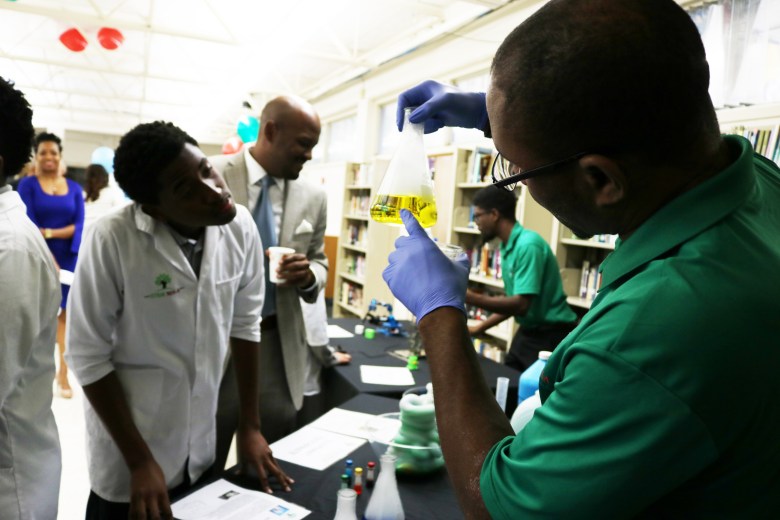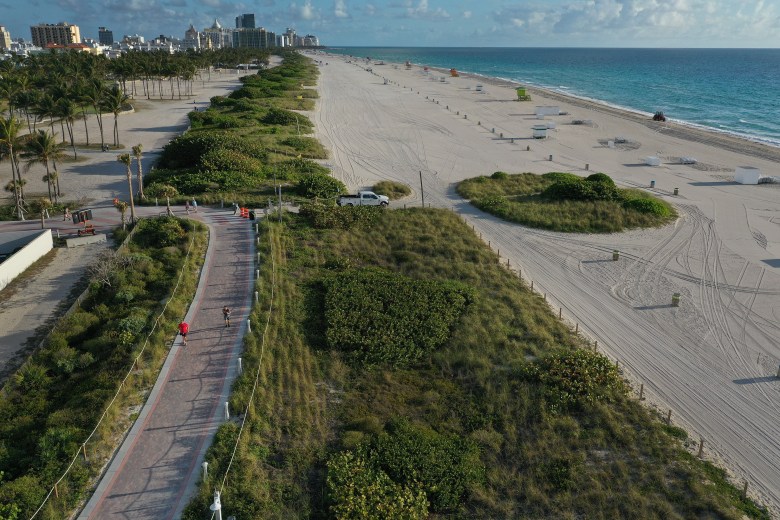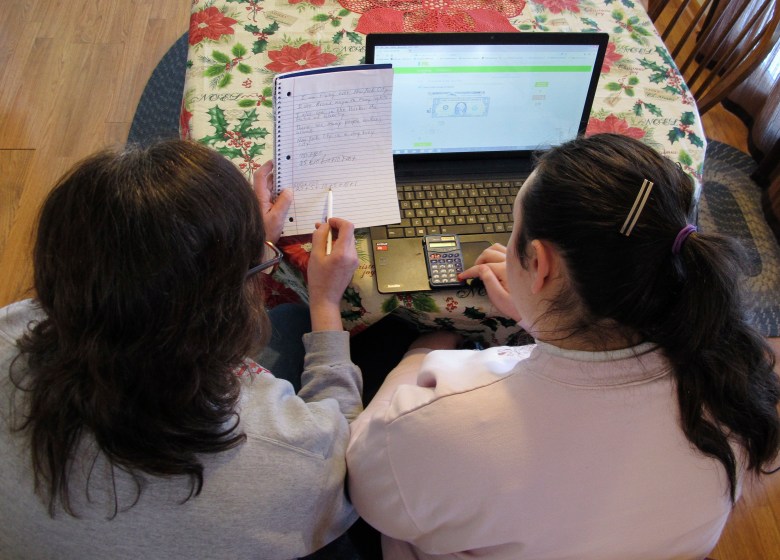This story was produced as part of the nine-part series “Are We Ready? How Schools Are Preparing – and Not Preparing – Children for Climate Change,” reported by HuffPost and The Hechinger Report, a nonprofit, independent news organization focused on inequality and innovation in education.

On the eve of each hurricane season, Jamar McKneely worries that this one will bring the next Katrina. McKneely was a teacher at Edna Karr High School in New Orleans when the 2005 hurricane devastated the city and closed his school for months.

But instead of a deadly hurricane, this year brought another crisis that shut the city’s school system: the coronavirus pandemic. McKneely, who now leads InspireNOLA Charter Schools, is trying to use this latest emergency to prepare for future natural disasters and disease outbreaks that are worsening due to climate change. His schools have been scrambling to set up online learning, connect students with virtual counseling and get laptops into the hands of families — steps McKneely says will be invaluable if another hurricane disrupts education.
“We are building all of that now to make sure we’re better prepared,” he said. “For us it might be the coronavirus or the next epidemic, but it could easily be the next hurricane as well.”
Like McKneely, some educators, government officials and policy experts around the country say the coronavirus carries lessons for another global crisis of our time, climate change. So far, the pandemic has revealed the challenges of conducting education remotely as well as uneven access to Wi-Fi and devices such as laptops. Overcoming those difficulties could equip schools for a future in which severe floods and fires increasingly batter communities and pause in-person education. The coronavirus could serve as a reminder to educators to reinforce the value of science education and the need for quality mental health services for kids.
Are We Ready?
This nine-part series explores how we’re teaching through climate change. We report on how climate change emergencies are disrupting student learning, exacerbating mental health problems, devastating school infrastructure, and how the coronavirus pandemic is a preview of what education looks like in a climate emergency. We also look at how textbooks are coming up short in teaching kids about climate, how medical schools are preparing future doctors, and how despite the obstacles some educators are finding ways to give students skills they need to better protect themselves and their communities.
School leaders “should be keenly aware that this is not just a one-time thing,” said Linda Darling-Hammond, president of the nonprofit Learning Policy Institute and of California’s State Board of Education. “If you’re thoughtful about it,” she said, “and you really start to think about closing the digital divide, making sure every kid has connectivity and devices, creating the curriculum strategies that are continuous, and helping teachers and other school staff understand what we have to do if schools are closed, then we can be better prepared for these eventualities that are going to become more and more frequent.”
Why Some Florida Districts Were at the Ready
Perhaps no school system had a distance learning plan in place that anticipated a shutdown on the scale of the coronavirus closures. But some places were more prepared than others. When Darling-Hammond looked around recently for school districts with online education plans that California might learn from, hurricane- and flood-prone districts in southern Florida stood out, she said.
The Miami-Dade school district, for example, adopted a plan back in 2012 to close the digital divide. It was initially designed to “obliterate digital deserts,” said Superintendent Alberto Carvalho, but the plan has also helped position the district to keep learning going amid disruptions like the flooding that routinely submerges parts of Miami.
“Because we are a coastal community prone to hurricanes, a coastal community prone to the arrival of literally dozens of thousands of children, immigrants,” Carvalho said, “we have naturally adapted to dealing with crises whether they are human crises, environmental crises or health crises.”

Back in January of this year, Carvalho told staff to keep an eye on the emerging coronavirus outbreak. In the weeks that followed, the district surveyed parents about their technology needs, took an inventory of devices such as Chromebooks and Wi-Fi hotspots, and assembled digital learning content under one portal that teachers and students could access easily. Those efforts allowed the district of 520 schools and educational centers to transition relatively smoothly from traditional learning to distance learning when the school system shut on March 16, Carvalho said.
By mid-April, about 111,000 devices and 11,000 hotspots had been distributed, he said. Approximately 92 percent of students are marked as present for remote classes (meaning they logged in to the online portal), which is only a percentage point or two behind school attendance the previous year at this time, Carvalho said. But even with online learning plans, school districts around the country could face an “unprecedented historic academic regression” unless they do more, he said. To stave off this learning loss, Miami-Dade is adding summer sessions and working to identify vulnerable kids and pair them with virtual tutors and mentors, among other steps.
“Because we are a coastal community prone to hurricanes, a coastal community prone to the arrival of literally dozens of thousands of children, immigrants … we have naturally adapted to dealing with crises whether they are human crises, environmental crises or health crises.”
Alberto Carvalho, Miami-Dade superintendent
In neighboring Broward County, Superintendent Robert Runcie said he had been receiving calls from school administrators in Chicago, Los Angeles and elsewhere, asking for advice on distance learning. Like Miami-Dade, the Broward system was able to quickly ramp up remote learning in part because of provisions it had put in place in the event of hurricanes. The coronavirus offers an opportunity to rethink how education is delivered in ways that could make school systems nimbler and more effective in serving students going forward, according to Runcie. “They say never waste a crisis,” he said.
How Forest Fires Are Prompting California to Rethink Strategies
Across the country in California, worsening fires, floods and droughts have forced some educators to contemplate a school calendar marked by natural disasters. Half of the 20 most destructive wildfires in state history have occurred since 2015. In the 2018 school year, roughly one in every five California school children missed at least one day because of a natural disaster, school maintenance issue, shooting or other emergency, according to an analysis by CalMatters.
That doesn’t mean that school districts were up to speed on distance learning, however. When schools closed for the coronavirus, an estimated 1.2 million kids statewide lacked access to Wi-Fi and computers. As of mid-April, schools had distributed supplies to meet about half of that need, said Darling-Hammond.

In Occidental, California, Matthew Morgan, superintendent of the Harmony Union School District, said the pandemic has exposed a big digital divide and online learning was slow to roll out. “We don’t have a distance learning plan that is operating on all cylinders,” he said in April.
But filling those gaps, he said, could help if poor air quality from wildfires keeps kids from going to school. That’s been a reality the last few years. Sonoma County, where Harmony is located, has been pummeled by fires in recent years. The 2017 Tubbs Fire caused evacuations and killed more than 20 people in the county. Smoke from the deadly 2018 Camp Fire, which leveled the town of Paradise 200 miles north, compromised air quality in Sonoma. And last fall, the Kincade Fire forced the largest evacuation in Sonoma County history.
In other ways, the district is drawing on its experiences living through emergencies. The close relationships Harmony forged with local government agencies because of wildfires helped it keep families and staff informed as the coronavirus spread, he said.
At Hall Middle School, in nearby Marin County, science teacher Rebecca Newburn said the disruptions to learning have forced her to streamline lessons and prioritize the content and skills that are most important. “Some things are going to get less attention this year,” she said, but “climate change is still super significant.” Her students are learning to cite evidence in making arguments, a skill that seems even more relevant now as the two global crises of coronavirus and climate change underscore the dangers of ignoring science and facts. She’s also trying to ensure that her kids are mentally resilient by taking breaks from learning to check in on their well-being and to process feelings.
“This is going to be an ongoing challenge,” Newburn said of the health and environmental issues that disrupt education. “Our curriculum and our schools are going to get disrupted multiple times, and the more we can be thoughtful and proactive about how we approach those disruptions and providing more stability and support for students, I think the better off we are all going to be.”
But in the South …
In the hurricane-prone Gulf, lessons from past disasters have helped schools think differently about which of their students’ needs to prioritize. But more work needs to be done to shrink the digital divide.
After living through Hurricane Katrina, McKneely, the charter school network CEO, knew to make student and staff mental health his first priority. The first thing he did upon learning that schools would close because of the coronavirus was to establish phone contact with families and set up phone lines with social workers so that parents and kids felt informed and supported. “What we learned from Katrina is that our students experienced a bunch of separation, of loss,” he said. “It was the trauma of the new norm, of not being able to go to school, to see their classmates, their teachers. We wanted to deal with that first.”
Loss came quickly: On April 2, a beloved football coach at McDonogh 35, which is part of the charter school network, died of the coronavirus. The school held calls with staff members and students, arranged counseling hotlines and extended spring break to give families time to cope.
On the academic front, InspireNOLA schools were less prepared, McKneely said. They had a short-term plan in place: Hand out homework packets to students of the sort that the schools provide over holidays. But there was no long-term plan, McKneely said. “We’re still learning how to fly as we’re flying,” he said.
“We are building all of that now to make sure we’re better prepared. For us it might be the coronavirus or the next epidemic, but it could easily be the next hurricane as well.”
Jamar McKneely, CEO, InspireNOLA charter schools
His schools are high-need, with more than 95 percent of students receiving free or reduced-price lunch, a federal measure of poverty. McKneely quickly discovered that the share of families who lacked Wi-Fi, laptops and other tools necessary to participate in remote learning was even greater than anticipated – some 40 percent. The school district, NOLA Public Schools, provided some Chromebooks and hotspots that the school operator distributed to families. But because of funding, logistical and other challenges, only about 28 percent of those in need have received the equipment so far. InspireNOLA also began trying to get teachers at all levels acquainted with the learning platform Google Classroom, which it had previously used for high school.
Now, McKneely said, his schools are trying to figure out a long-term plan for learning through emergencies. They are determining how they might transition all aspects of the school’s education – grading, social and emotional support, staff calls, lessons – online. When schools reopen, they might do so with a different schedule: four days a week of in-person education and one virtual day, for example. McKneely said he wants all his students to be accustomed to learning outside a school’s walls in the event of a second wave of the coronavirus or another Katrina.
Going forward, McKneely worries about not just another deadly hurricane, but another coronavirus outbreak before a vaccine is developed. But he has reasons for hope, recalling “how we came together to rebuild our city” after Katrina. He added: “I hope the same camaraderie, passion and commitment can be made to our students’ families to make sure their sense of normalcy as well as their advancement continues.”
What Experts Say We Need for Distance Learning
It’s hard to know exactly what distance learning might look like a few years from now, said Sujata Bhatt, a senior fellow with Transcend, a nonprofit that works with school systems to improve how they deliver education. Schools are still scrambling simply to cope with the immediate coronavirus crisis and meet students’ basic needs, she said, but the next school year could present opportunities to rethink how remote learning happens.
One big step forward would be universal broadband access, said Lillian Pace, vice president of policy and advocacy with the nonprofit KnowledgeWorks. Another is making sure teachers receive training on distance learning, through programs that prepare them for the profession as well as through ongoing professional development. “It’s going to have to be built in as a new baseline of entry into the profession,” said Pace.
“Our curriculum and our schools are going to get disrupted multiple times, and the more we can be thoughtful and proactive about how we approach those disruptions and providing more stability and support for students, I think the better off we are all going to be.”
Rebecca Newburn, middle school science teacher
Education systems will also have to adjust how they assess students and schools. Measures like seat time and attendance just won’t work the same way in a world facing so much disruption. Instead, we could see a shift toward evaluating students based on whether they’ve mastered certain skills, said Katherine Prince, senior vice president of strategic foresight with KnowledgeWorks. And schools will need to find ways to prioritize kids’ emotional and social well-being, she said, and provide them with the sense of working collaboratively with peers even when they’re stuck at home.
David Cook, who leads the Division of Innovation within the Kentucky Department of Education, has been working since 2011 to find ways to keep kids learning through snowstorms and floods. (Notably, climate change could reduce snowfall in the state but worsen flooding.)
Before the coronavirus pandemic hit, 83 of the state’s school districts had in place a “nontraditional education” plan by which teachers prepared lessons that kids could access remotely if needed. Since March, the program has expanded to all of the state’s 172 districts. Now Cook is studying how to revise the program given that school closures of the future are likely to last weeks and months, not days. Whatever happens with this current crisis, Cook said, distance learning seems poised to be a bigger part of education going forward.
“The notion of everything happening in a building between 8 and 3,” he said, “is probably not something we’re going to go completely back to.”
— Rebecca Klein contributed reporting to this story.

